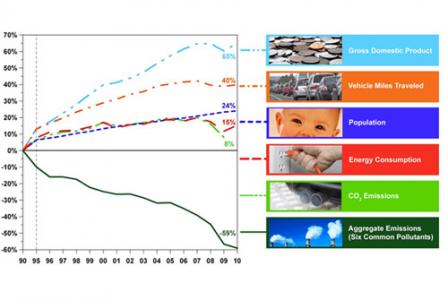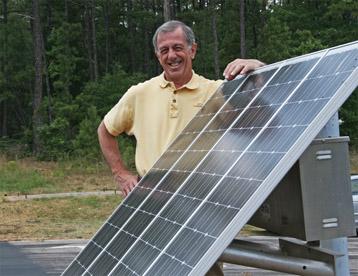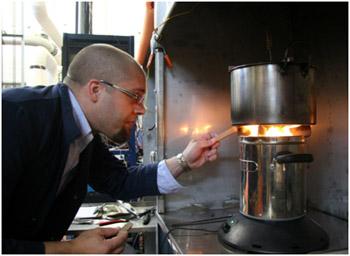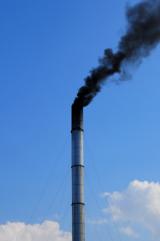EPA Science Matters Newsletter: Volume 3, Number 2
Published June / July 2012
About this Issue
- By the Numbers: About this Issue
 Comparison of Growth and Air Emissions, 1990 – 2010
Comparison of Growth and Air Emissions, 1990 – 2010
Source: U.S. EPA, Office of Air and Radiation.
Our Nation's Air, status and trends through 2010The numbers tell the story. Between 1990 and 2010, U.S. gross domestic production increased by some 65%. Total miles traveled by U.S. vehicles went up 40%. The population grew by 24%, and energy consumption rose 15%. And amongst all that growth and activity, the country's air got significantly cleaner: levels of six major categories of air pollutant emissions dropped 59%.
The impact of that reduction includes another impressive number: five months. That's the estimated increase in life expectancy attributed to cleaner air for those living in certain urban areas, based on an EPA-supported study Exitpublished in the New England Journal of Medicine.
How was that achieved? It all started with science. Science-based air pollution regulations under the Clean Air Act have helped advance remarkable success in making the air cleaner and healthier for communities across the nation.
But there is still work to be done.
"There have been great strides since the passage of the Clean Air Act in 1970, almost to the point now, when we look outside, the air is clear in most places—even in most urban environments—and we kind of forget the fact that there are things in the air that while we can't see them we can inhale them," said EPA air scientist Dan Costa, Sc.D., DABT.
Dr. Costa, the National Program Director for EPA's Air, Climate, and Energy research program is just one of the EPA experts featured in this issue of EPA Science Matters, which focuses on the impact and ongoing efforts of EPA air research.
Highlighted are stories about EPA's efforts to better understand the complex interrelations between air, climate, and energy, including: a recent study illuminating how exposure to ground-level ozone may be linked to heart trouble, the potential health impacts of biodiesel fuels emissions, research exploring how black carbon affects the climate, the efforts of EPA engineers to design clean-burning cookstoves to improve the health of hundreds of millions of people.
40 years of EPA air research have added up to provide significant and lasting impacts in the form of cleaner air and healthier communities. And that important work continues to advance the science and engineering needed to meet the far-reaching and complex challenges facing us today.
Read this issue of EPA Science Matters to learn more.
GEMS: Great Environmental Moments in Science
- Matters of the Heart: Air Pollution and Cardiovascular Disease
EPA scientists explore the link between elevated ozone and heart disease risks

Most people don't pay much attention to the constant thump-thump, thump-thump, thump-thump, of their heart beating away in their chest. After all, the prescription for heart health is generally well known - a tried and true combination of eating a low fat, high-fiber diet, not smoking, staying active, and keeping your blood pressure and cholesterol level in check. For some, a doctor-recommended daily dose of aspirin is part of the routine.
Now, however, emerging EPA research is pointing toward what could very well be an important missing ingredient, especially for those already at risk of heart attacks: keeping an eye on your local air quality index.
"Five percent or more of heart disease deaths are possibly related to air pollution exposure," says Wayne Cascio, MD, Director of EPA's Environmental Public Health Division.
Dr. Cascio, a cardiologist, and his research team are exploring the potential effects of air pollution exposure on cardiovascular health. He is also the leading force behind the Agency's "Green Heart Campaign" to increase awareness among public health professionals, doctors, nurses, other healthcare providers, and individuals that air pollution is a risk for those with heart disease.
The effect of air pollution exposure on the lungs has been well studied. Research shows that breathing in increased levels of tiny particles of air pollution (fine particulate matter or PM2.5) and ground-level ozone can lead to lung inflammation, decreased lung function, and an increase in asthma attacks. Extensive studies have also shown that particulate matter can contribute to and cause cardiovascular problems.
And now EPA researchers are exploring the link between ozone exposure and cardiovascular health.
Researchers in Cascio's division have discovered that ozone exposure can trigger inflammation of the vascular system and increase risk factors associated with heart disease.
"We found a linkage between ozone and increases in two risk factors for heart disease: a change in heart rate variability and a reduction in the ability of blood clots to dissolve," said Robert Devlin, Ph.D., an EPA senior scientist and lead author on a paper published in the American Heart Association's journal Circulation that describes one of the first studies looking at the effects of ozone exposure on heart health.
Cascio, Devlin, and other EPA researchers are planning additional studies and will expand the suite of factors they examine, including exploring the impacts of ozone on resting heart rates versus the impacts while exercising. This type of test, similar to cardiac stress tests routinely performed in doctors' offices, will give insights into the potential for ozone exposure to trigger the heart to beat irregularly, too fast, or too slow.
EPA's research on air pollution and cardiovascular disease provides key information to public health officials and health care providers, who can then use it to issue advisories that alert those at risk to take action, such as limiting outdoor activities during periods of elevated ozone and "Air Quality Action" days.
With increased awareness of a link between air pollution and heart health, Cascio hopes people will keep themselves informed about their local air quality conditions. That information is readily available through EPA's Air Quality Index (AQI) and the AirNow App, a free smartphone App (available on iPhone and Android) that provides real-time air quality information. A tool called EnviroFlash also provides email and text message updates about local air quality data. "EnviroFlash is an easily accessible tool to help people plan activities around periods of increased ozone levels and other air pollutants," says Cascio.
Learn More
- Too close for comfort? Living Near Major Roads May Impact Your Health
EPA researchers and partners are studying the local health effects associated with roadways and other "near-source" air pollutants.

Noisy car and truck traffic may not be the only problem for those living next to a major road. Being close to the road may also cause health problems, especially for children and the elderly.
A recent EPA-funded study ("Residential Proximity to Major Roadway and 10-Year All-Cause Mortality After Myocardial Infarction" Exit Circulation. May 7, 2012) conducted by researchers at EPA's Clean Air Research Center at Beth Israel Deaconess Medical Center Exit found that heart attack survivors who live less than 100 meters (328 feet) from a major road have a 27 percent increased risk of dying over 10 years than those living at least 1,000 meters (3,280 feet) away. The study is another addition to an emerging body of science showing that people who live, work, or attend school near major roads are at increased risk of health problems related to roadway air pollution.
Other health effects associated with near roadway exposures include asthma, cardiovascular disease, low birth weight, pre-term birth, premature death, reduced lung function, and impaired lung development in children. EPA scientists are investigating the health impacts, types, and amounts of air pollutants emitted along major roads and other 'near source' air pollution sites, such as airports, rail yards, and ports.
"In order to protect public health, we need to study near the sources of air pollution so that we can provide solutions for reducing or minimizing exposure and potential health impacts," says Dan Costa, the national program director for EPA's Air, Climate, and Energy research program.
Results of the work provide important information to urban and transportation planners and state air quality managers working to reduce pollutant levels and protect public health. For example, the near-roadway research contributed to the development of the School Siting Guidelines, an EPA publication produced, in part, to help school districts evaluate potential environmental hazards when picking locations for new schools.
The near-source research engages scientists and engineers from a diversity of disciplines and includes many partners.
Other examples of near-source research include:
Along the Road

- In partnership with the University of Michigan, researchers are conducting a major study exploring near-road air pollutants and related health impacts on children who suffer from asthma. (See Can Highways Contribute to Asthma? "EPA Science Matters," February, 2011.)
- EPA scientists are also investigating how road design and roadside features (sound walls, vegetation, buildings) may be used to reduce air pollution exposures.
- Check out a video about EPA's "air-sniffing" car used for studying air pollution along the road
Along the Port

- EPA researchers are conducting a long-term air monitoring study to assess impacts from emission improvements at the Port of New York and New Jersey. The port is the third largest (by tonnage) in the country and the busiest on the East Coast.
- EPA scientists are studying how expansions to the Panama Canal—expected to spark an accompanying increase in oceanic trading and ports—may lead to rises in air pollution along the Gulf Coast and East Coast of the U.S.
Along the Tracks

- EPA recently finished a major rail yard study located near Chicago and is analyzing the data collected. A second rail yard study is planned for Atlanta (expected to begin in mid-2012).
Learn More
- Questions and Answers with EPA Air Scientist Dan Costa, Sc.D., DABT
The National Program Director for EPA's Air, Climate, and Energy research program answers questions about air science.
The latest Science Matters podcast features Dr. Dan Costa, an EPA scientist and the National Program Director for the Agency's Air, Climate, and Energy (ACE) research program.
Below are a few highlights of the conversation. Listen to the entire conversation:
(mp3, 13.3 MB, 14:31min)Science Matters: Can you give us a quick overview of EPA's air, climate, and energy research? Why is EPA studying these issues together as a unified program?
Dr. Dan Costa: I think that's a great question.
Over time, it's become increasingly clear that these issues—air pollution, climate change, and energy production and use—are deeply intertwined.
Our choices in energy, whether it's fossil fuels, or wind or solar, have implications for air quality and climate change; and climate change impacts local air quality, as well as our energy infrastructure. So it's very logical, if we're ever going to really make headway, that we look at these issues in a comprehensive and interactive, systems-based manner.
Science Matters: Over 40 years of research, what kind of advances have we made with respect to air pollution, and what are the challenges we're still facing?
Dr. Dan Costa: There have been great strides since the passage of the Clean Air Act in the 70s, almost to the point now, when we look outside, the air is clear in most places—even in most urban environments—and we kind of forget the fact that there are things in the air that while we can't see them we can inhale them.
When the Clean Air Act was first passed, while we knew air pollution was a big mixture, we couldn't understand the multiple-pollutant environment. So, we looked at what were the most ubiquitous and important pollutants that would likely have a health impact—the so called 'criteria pollutants' (ozone, particulate matter, etc.), and we focused our studies on those. Since then, overall pollution levels have decreased some 85%. For example, the automobile produces just a few percentage points of the emissions that it did in 1970. Industry also figured out that by being more efficient and reducing pollution, they were in fact pushing their own positive economies.
And yet there are 120 million people in the U.S. living in areas that are still out-of-compliance with today's pollution standards.
We've been able—through sensitive testing procedures, evaluations, and risk assessment—to see that there are people who are affected by low levels of pollution, especially over long periods of time.
There are a number of issues that we still have to deal with in achieving the American ideal.

Science Matters: Much of your research has been focused on working toward a "one-atmosphere" model. Can you elaborate on what you mean by that?
Dr. Dan Costa: "One atmosphere" is part of our systems thinking. We know air pollution is a complex mix of pollutants. It's not just the six criteria pollutants. Air pollution varies by location, source, meteorology, atmospheric chemistry, and other factors.
We know that the world is 80% water; we know the land is a constant dynamic of vegetative changes; we know that certain pollutants that derive from nitrogen deposit on soil and water and have an impact on plants.
All of these systems are interlinked, and our visionary goal is to start to pull together these compartmentalized models and bridge them into a "one-environment model."
We've gone about as far as we can trying to do things on a pollutant-by-pollutant basis, so we need to look at the whole atmosphere in assessing risk. How does an individual pollutant behave in a complex mix? How does the mix change as we reduce that individual pollutant?
It's not going to be simple. And, for the sake of accessibility for our partners and local decision makers, we don't want a model that requires a supercomputer to run.
Science Matters: How does EPA modeling support the work of environmental decision-makers?
Dr. Dan Costa: Air pollution models, and many other kinds of models developed by EPA and its partners, are used daily by environmental managers, scientists, and government decision-makers at the state, local, and community levels.
The question is: How can we look at these air, climate, and energy issues in a dynamic and predictive way so that these leaders can make informed decisions?
What's the impact if we reduce this emission? Does it affect something else? Everything has alternative consequences. Some can be negative; some can be positive. We like the idea of co-benefits; for example, reducing black carbon from cookstoves has a public health benefit and a climate change co-benefit.
Models help us maximize these synergies and deliver the biggest environmental bang for the buck that we can. We know from our history that—if we're strategic and we think and apply ourselves appropriately with a cooperative effort—we can have both environmental protection and a robust economy.
Learn More
- Cleaning Up In the Kitchen: Cleaner Cookstoves
EPA researchers and partners are working to improve cookstoves to protect millions from unhealthy indoor air and help improve the global climate at the same time.

For roughly half the world's population, the source for both cooking and keeping warm is a simple fire pit surrounded by three large stones arranged to keep a cooking surface above the flames. For the people who rely on them, these simple and inexpensive "solid fuel" cookstoves do the job.
But they are also the world's leading source of environmental death due to indoor air pollution.
A 2009 report Exitby The World Health Organization estimates that the indoor air pollution from typical household cooking fires contributes to nearly 2 million premature deaths annually. "Indoor smoke from solid fuel causes about 21% of lower respiratory infection deaths worldwide, 35% of chronic obstructive pulmonary deaths and about 3% of lung cancer deaths," the report states.
 EPA recently revamped its stove testing laboratory. Located on EPA's campus in Research Triangle Park, NC, the lab was expanded to include more instrumentation and now has the capability to test stoves with chimney up to five meters tall. Pictured is Seth Ebersviller, USEPA post doctorial fellow.
EPA recently revamped its stove testing laboratory. Located on EPA's campus in Research Triangle Park, NC, the lab was expanded to include more instrumentation and now has the capability to test stoves with chimney up to five meters tall. Pictured is Seth Ebersviller, USEPA post doctorial fellow.EPA engineers and scientists are part of an international effort to develop a new generation of clean burning cookstoves that will bring relief across the developing world. Their work has the potential to clear the air in millions of homes and help reduce soot emissions linked to both health impacts and the effects of global climate change. (see below: Black Carbon Research)
Together with the U.S. Department of State and several other federal government and private sector partners, EPA research supports the U.N. Foundation's Global Alliance for Clean Cookstoves Exit, a public-private alliance working to address the problem of polluting cookstoves. As part of that broad effort, EPA researchers have been working with the Global Alliance to test cookstove designs and help guide the development of new, cleaner technologies.
In 2011, EPA researchers conducted an extensive round of cookstove testing. Expanding on previous work (see Better Burning, Better Breathing), they tested 44 combinations of stoves, fuels, and operating conditions for emissions and fuel efficiency.
"You also see the power of the market in the Global Alliance for Clean Cookstoves, which aims to help 100 million families adopt clean cookstoves and fuels by 2020. By supporting consumer research and creating incentives for manufacturers, we're helping to create a market for stoves that people will pay for and use, while at the same time preventing health problems in women and children, and cleaning the air of black soot" - Secretary of State Hillary Rodham Clinton during her remarks at the recent UN Conference on Sustainable Development in Rio De Janeiro
Research results identified designs that offer increased fuel efficiency and lower pollutant emissions, as compared to traditional cooking methods. They found that stoves made from lighter and less dense materials tended to reduce cooking times, thereby increasing fuel efficiency and lowering emissions.
EPA engineers are providing test data and other useful information to the Global Alliance for Clean Cookstoves and others who supply stove technology to developing countries. The engineers and their partners are now evaluating test results to identify the most promising stoves for field trials and to further improve testing methods. What they learn will hopefully lead to cleaner and healthier living conditions for people across the globe.
Black Carbon Research
The thick, particle-laden smoke emitted from cookstoves is not just a local issue threatening the health of poor families in the developing world. Much of this smoke is composed of "black carbon," a solid form of mostly pure carbon that absorbs solar radiation (light) at all wavelengths.
Black carbon (BC) represents a significant portion of fine particulate matter (PM2.5) air pollution. Numerous EPA and other studies have associated BC with a broad range of adverse health effects, including asthma, heart attacks, low birth weight, and lung cancer.
"Black carbon forms in flames when there is not enough oxygen in the mix and temperatures are not as high as they need to be to ensure that BC is converted to CO2 before it can be emitted into the atmosphere. Older diesel engines, brick kilns, coke ovens, and open biomass combustion that burn fuel under these conditions are major sources of BC pollution around the world. More modern engines and industrial boilers are designed to be cleaner and more efficient by ensuring there is plenty of oxygen, and high temperatures, in the burning zone," explains EPA's Dr. Brooke Hemming.
Although modern engines and industrial facilities have helped to greatly reduce black carbon emissions in developed countries like the United States, BC pollution is still a serious concern in the U.S. and across the world.
Black carbon has also been identified as a significant contributor to climate change, particularly in sensitive areas such as the Arctic and the Himalayas where its "albedo" effect—the direct warming that occurs when reflective ice and snow are darkened by with black carbon particles—contributes to earlier spring melting and sea ice decline.
EPA scientists and their partners are conducting research to better understand the effects of black carbon on human health and the environment, both locally and globally. EPA engineer Carlos Nuñez notes "If we want to find the most effective ways to reduce the health and environmental impacts of black carbon, we need to develop the best information we can on its sources, how it behaves in the atmosphere, and how it ultimately affects human health and the environment."
Examples of EPA's efforts are:
- Nine EPA Science to Achieve Results (STAR) grants totaling more than $6.6 million have been awarded to eight universities to support research analyzing the impacts of black carbon on air and water quality, investigate the behavior of black carbon aerosols in the atmosphere, and develop innovative computer models and other tools to look at black carbon deposits on snow.
- EPA is collaborating with the University of Michigan on the Near-Road Exposures to Urban Air Pollutants Study (see Can Highways Contribute to Asthma?) evaluating the impact of vehicle emissions, including black carbon, on near-road exposures and asthma.
- An EPA team is using a sophisticated model called GLIMPSE (Geos-CHEM LIDORT Integrated with MARKAL for the Purpose of Scenario Exploration) to examine the complex scenarios, tradeoffs, and effects of actions taken to reduce black carbon and other atmospheric pollutants.
- EPA researchers are evaluating different methods for measuring black carbon in controlled and real-world conditions to better understand how black carbon is related to other forms of carbon-based particles and to identify the most effective approaches to black carbon measurement.
Learn More:
- Modeling Matters
EPA scientists are developing advanced models to monitor pollution exchanges between air, water, and land.

Historically, people have considered air, water, and land as separate systems, leading to divided research and management efforts. The Clean Air Act and the Clean Water Act, for example, provide distinct mandates for how the EPA sets regulations to safeguard these critical resources and to protect human health.
But, of course, air, water, and land are intricately linked: there is constant exchange between them across multiple scales—including the exchange and deposition of pollution. While EPA scientists have long used models to better understand how chemical constituents cycle through air and other systems separately, they are now tackling the challenge of linking them into connected, cross-media models that better reflect the complexity of real world conditions.
"To understand how the atmosphere moves the stuff that is put into it, scientists use models—collections of equations built from what we know," writes EPA research scientist Tanya Otte in her blog post titled Modeling Matters.
The world is interconnected and we need to start modeling it as such. While we couldn't do it before because of a lack of computer power and sophisticated modeling capability, we are closer than ever. Now is the time. - Dr. Robin Dennis, EPA Scientist
Dr. Robin Dennis, a senior scientist in EPA's Atmospheric Modeling and Analysis Division, is leading a team of Agency researchers and outside experts to develop a prototype set of models linking air, water, and terrestrial systems. These models will then be connected to a combined health and welfare benefits mapping tool, allowing policymakers to be more effective in maximizing the benefits and minimizing the costs of the environmental regulations they put into place.
"The world is interconnected and we need to start modeling it as such. While we couldn't do it before because of a lack of computer power and sophisticated modeling capability, we are closer than ever. Now is the time," says Dennis.
Making the Connection: Nitrogen as a Multimedia Pollutant
One focus area for new modeling research is excess reactive nitrogen pollution, one of the country's most widespread and challenging environmental problems. Reactive nitrogen is natural and, in moderation, helps plants grow. But agricultural and industrial activity has gradually added more and more reactive nitrogen into the nitrogen cycle, beyond what ecosystems can handle.
Excess reactive nitrogen in soil, water bodies, coastlines, and the atmosphere is contributing to a host of environmental and human health effects, including acid rain, smog, particulate matter, coastal dead zones, harmful algal blooms, contaminated water, stratospheric ozone depletion, and global climate change.
For Dennis and his team, the ultimate goal is to track nitrogen—and other pollutants like sulfur oxides (SOx) and mercury—with a multimedia, one-environment modeling system. A model of this complexity is years away, but the team has started to build it in stages. The key pieces they are working on include:
- reducing uncertainty in atmospheric deposition models (how pollution moves between air and ground);
- connecting meteorology (atmosphere, weather) and hydrology (water systems) models to connect the hydrosphere for advanced climate and land-use change analysis; and
- expanding the capabilities of the atmospheric modeling system to better link to the ecosystem models.
This last piece—linking to ecosystems and "ecosystem services"—is the most challenging. The ecosystem models concern many things we care about in addition to clean air: water quality, water resources, biodiversity, and the health of our communities. As these prototype linkages become more developed, policymakers will be better able to zero-in on multiple pollution sources and problem areas and avoid unintended consequences as they craft solutions. By 2016, researchers hope to incorporate the effects of climate change at the regional level.
Improving the MARKAL model to Support Energy Decisions
EPA scientists are also improving existing models. A team of EPA scientists is developing databases of U.S. energy production to advance the capability of the MARKet ALlocation (MARKAL) model. This model, created in the late 1970s by the Brookhaven National Lab, identifies the complex tradeoffs involved in choosing between energy sources.
EPA's team uses MARKAL to compare how different energy use scenarios—such as the expanded use of electric vehicles, biofuels, hydrogen fuel-cell vehicles, large-scale batteries, and solar power—could affect air pollution, greenhouse gas emissions, and water use.
"Electric vehicles are a good example of how our choices in producing and using energy are all interrelated," explains EPA scientist Rebecca Dodder, a member of the MARKAL research team. "We can use MARKAL to examine different ways that these choices could play out, gaining important insights about their environmental implications."
- Health Effects of Biodiesel
EPA researchers examine biodiesel emissions

That converted bus rumbling up next to you at the red light during your morning commute and smelling like a roving fast food restaurant may be running on old French fry grease. The quest for more sustainable, domestically produced alternatives to petroleum-based fuels has sparked a growing interest in biodiesel—fuels made from vegetable oils (mainly soybean and rapeseed), animal fat, or recycled restaurant grease.
The benefits of biodiesel are many. Biofuels can be used alone, or blended with petrodiesel (conventional diesel fuel) to power vehicles and as a low carbon alternative to fuel cars and heat homes. These domestically produced fuels are generally safe to handle, naturally biodegradable, and often help convert waste—such as used cooking grease—into a marketable commodity.
But while the allure of biodiesel is powerful, there are important questions about their long-term health impacts that are being addressed by EPA researchers.
"Our research is focused on assessing the full impacts of this emerging technology. We hope to be able to better understand the health effects of biodiesel—from producing the fuel, to burning it—and to make comparisons with petrodiesel," says EPA scientist Ian Gilmour, Ph.D.
Gilmour and a team of EPA researchers, including Michael Madden, Steve Gavett, Bill Linak, Mike Hays, Urmila Kodavanti, Aimen Farraj, and David DeMarini, are using previous exposure studies such as diesel exhaust and smoke from forest fires to guide them in studying biodiesel combustion.
"We are comparing how the fuels burn and the amount and type of pollutants in the exhaust along with evaluating their toxicity," explains team member Michael Madden.
Biodiesel fuels are quite complex and are still not fully understood. "The chemistry is tricky —we don't have a complete understanding of how chemicals interact with each other when they are burned in an engine, and how the emissions will affect our health," Madden says.
The researchers are looking to see if components of biodiesel emissions are likely to have properties that trigger adverse health effects, including changes in gene structures, lung and cardiac reactions such as altered electrocardiogram (or EKG, a measure of the heart's electrical activity), heart rate variability (HRV), blood pressure (BP), and lung function in both normal and susceptible individuals.
"One of our key concerns is the emission of polycyclic aromatic hydrocarbons (PAHs)," says Gilmour. PAHs are one of the most widespread organic pollutants and released into the air when things are burned or cooked. PAH compounds have been identified as being able to change DNA structure, an indicator that it may potentially cause cancer.
EPA researchers are also studying the potential health effects of biodiesel blends (e.g. soybean oil mixed with petro-diesel). Biodiesel fuel sources and the amounts used to create blends are a constantly moving target because innovative technologies and market forces can dramatically change the fuel type or blend.
"Today in the US, soybean oil is the most widely available biofuel on the market. However, if oilgae Exit(algae-based fuels) or some other alternative fuel source proves to be more cost-effective, it's going to be very important to characterize them. We are working to develop the ability to create tests that we can use to quickly evaluate the health and environmental impacts of emissions from emerging fuel sources," says Gilmour.
What the EPA team is learning will help inform important decisions and guide research in the quest to develop alternative fuel sources that don't bring with them the unintended consequences of harmful emissions.
Learn More
- Anthrax in the Air?
EPA Homeland Security researchers and their partners are studying the potential for anthrax to "reaerosolize" in outdoor, urban environments following a bio-terrorist incident.

It's not hard to imagine the immediate aftermath of a terrorist attack using Bacillus anthracis (anthrax) spores. Emergency crews in bio-hazard suits survey the scene. A perimeter is established around large, evacuated areas, while victims are tended to by health professionals.
But what next? As clean up is planned and executed, can decision makers count on any settled spores staying put? Do environmental factors cause the spores to become airborne from outdoor, urban surfaces, and potentially enter buildings, vehicles, or other occupied areas?
If spores do move about, how does this situation influence the choice of clean up approaches and public health responses (exposure of workers and the public, sampling strategies, immunizations, clean up technology, etc.)?
Answering the above questions is the focus of a new, coordinated set of studies called the Scientific Program on Reaerosolization and Exposure (SPORE) — conducted collaboratively by EPA's Homeland Security Research Program (HSRP), the Department of Homeland Security, the Department of Health and Human Services, the Department of Defense, and other research partners.
SPORE researchers have already found that reaerosolization of anthrax spores can occur; however, more studies are needed to fully understand reaerosolization and improve our ability to estimate exposures to responders and civilians under various scenarios.
Over the next several years, SPORE will study and evaluate the biological properties of anthrax spores, anthrax dispersion and reaerosolization in a simulated outdoor urban environment, and potential impacts on public health. The results of this research will better inform field activities in the event of an actual anthrax attack. Ultimately, the goal is to make communities more resilient to anthrax attacks by not only protecting public health but by returning contaminated areas to use more quickly and economically.
Learn More
- Clean Air Technology Initiative: Improving Air Quality through Technological Innovation
EPA researchers join forces with local and state agencies to promote innovation.

According to School Transportation News, there are some 480,000 school buses in the United States, transporting approximately 26 million students to and from school.
It's no coincidence that the first zero-emission, all electric school bus belongs to the Kings Canyon Unified School District, situated in the San Joaquin Valley of central California and home to some of the nation's poorest air quality.
This school bus was purchased with grants from the San Joaquin Valley Air Pollution Control District, one of EPA's partners in an ambitious initiative launched to promote technological innovation that improves air quality and the economy.
The Clean Air Technology Initiative is a collaborative partnership uniting the EPA, California Air Resources Board, California Energy Commission, San Joaquin Valley Air Pollution Control District, and South Coast Air Quality Management District. Partners work with the private sector, non-profits, and academia to help bring new clean air and energy technologies to the marketplace through testing, demonstration, and deployment.
The Initiative is designed to help make two southern California regions that experience significant pollution challenges —the South Coast and San Joaquin Valley Air Basins—national examples of how local communities can tap innovation to meet health-based national air quality standards while sparking local economic development through the creation of green jobs.
In addition to school bus and other transportation technologies, the Initiative supports a host of other areas, including construction and agriculture equipment, air filtrations systems for schools, commercial "green" cleaners, residential yard equipment, boilers and heaters, natural gas locomotive engines, and more.
Learn More



